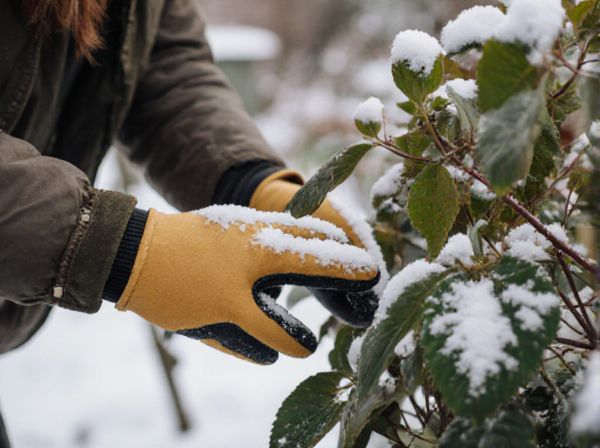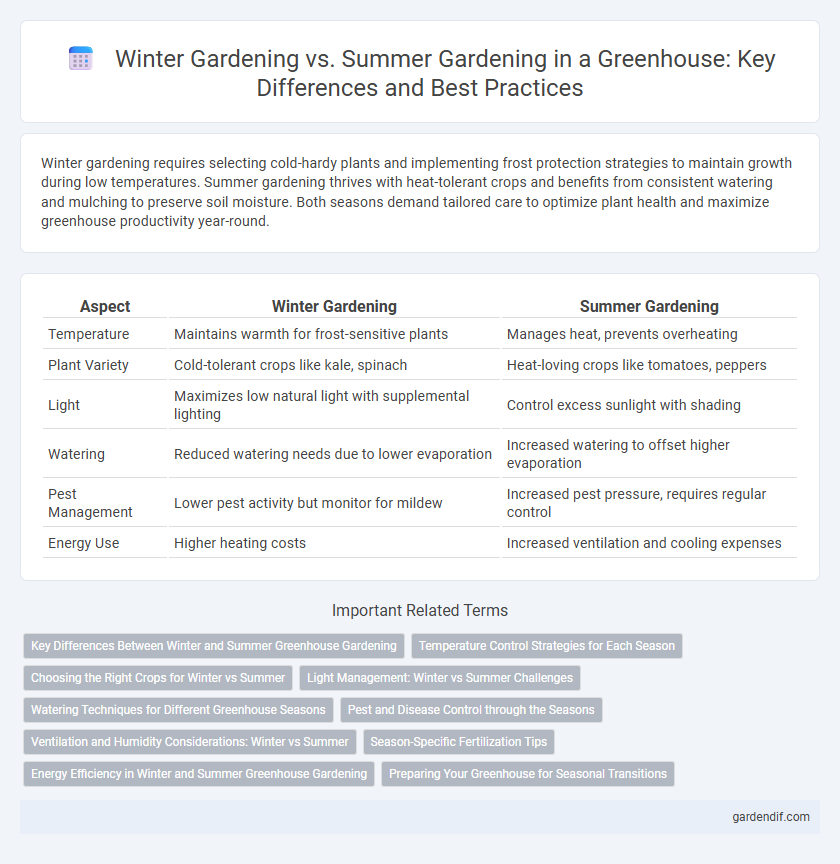
Winter Gardening vs Summer Gardening Illustration
Winter gardening requires selecting cold-hardy plants and implementing frost protection strategies to maintain growth during low temperatures. Summer gardening thrives with heat-tolerant crops and benefits from consistent watering and mulching to preserve soil moisture. Both seasons demand tailored care to optimize plant health and maximize greenhouse productivity year-round.
Table of Comparison
| Aspect | Winter Gardening | Summer Gardening |
|---|---|---|
| Temperature | Maintains warmth for frost-sensitive plants | Manages heat, prevents overheating |
| Plant Variety | Cold-tolerant crops like kale, spinach | Heat-loving crops like tomatoes, peppers |
| Light | Maximizes low natural light with supplemental lighting | Control excess sunlight with shading |
| Watering | Reduced watering needs due to lower evaporation | Increased watering to offset higher evaporation |
| Pest Management | Lower pest activity but monitor for mildew | Increased pest pressure, requires regular control |
| Energy Use | Higher heating costs | Increased ventilation and cooling expenses |
Key Differences Between Winter and Summer Greenhouse Gardening
Winter greenhouse gardening requires careful temperature regulation and insulation to protect plants from freezing, while summer gardening prioritizes ventilation and shading to prevent overheating. Light intensity and duration vary significantly, with winter gardening relying on supplemental lighting and summer gardening benefiting from natural sunlight. Watering needs also differ; winter plants generally require less frequent irrigation compared to the higher water demands in summer due to increased evaporation.
Temperature Control Strategies for Each Season
Winter gardening in a greenhouse prioritizes insulation techniques and heating systems such as electric heaters or thermal mass to maintain consistent temperatures above freezing. Summer gardening strategies emphasize ventilation, shading, and evaporative cooling to prevent overheating and sustain optimal plant growth conditions around 70-85degF. Advanced monitoring systems integrating thermostats and automated vents ensure precise temperature regulation tailored for seasonal challenges.
Choosing the Right Crops for Winter vs Summer
Selecting crops for winter gardening requires prioritizing cold-hardy vegetables like kale, spinach, and Brussels sprouts that thrive in lower temperatures and shorter daylight hours. In contrast, summer gardening favors heat-tolerant plants such as tomatoes, peppers, and cucumbers that flourish in warmer weather and longer sunlight exposure. Understanding the temperature and light requirements of crops ensures successful yields in seasonally optimal greenhouse conditions.
Light Management: Winter vs Summer Challenges
Winter gardening requires maximizing limited natural light by using supplemental grow lights and reflective materials to ensure plants receive adequate photosynthesis for growth. In contrast, summer gardening demands managing excessive sunlight through shading techniques and ventilation to prevent heat stress and photoinhibition. Effective light management balances intensity and duration according to seasonal variations to optimize plant health and yield inside greenhouses.
Watering Techniques for Different Greenhouse Seasons
Watering techniques in greenhouses must adapt to seasonal variations to optimize plant growth and conserve resources. In winter gardening, reduced evaporation rates and lower temperatures require less frequent watering with careful monitoring to avoid overwatering and root rot. During summer, increased heat and sunlight intensity demand more frequent watering, preferably early morning or late evening, and the use of drip irrigation systems to maintain consistent soil moisture without water wastage.
Pest and Disease Control through the Seasons
Winter gardening in greenhouses demands vigilant control of pests like aphids and spider mites, which thrive in cooler, humid conditions, while summer gardening requires managing whiteflies and fungal diseases exacerbated by higher temperatures and humidity. Effective pest and disease control methods include maintaining optimal ventilation, using insecticidal soaps, and implementing crop rotation to disrupt pest life cycles. Seasonal adjustments in temperature and humidity settings are crucial to minimizing pathogen proliferation and ensuring healthy plant growth year-round.
Ventilation and Humidity Considerations: Winter vs Summer
Winter gardening in a greenhouse requires careful humidity control to prevent mold growth, often achieved by reducing moisture and increasing ventilation using heaters and vent fans. Summer gardening demands enhanced ventilation to manage higher temperatures and humidity levels, utilizing roof vents, side vents, and evaporative cooling systems to maintain optimal air circulation. Proper ventilation in both seasons ensures plant health by regulating temperature and moisture, critical for preventing diseases and promoting growth.
Season-Specific Fertilization Tips
Winter gardening requires slow-release fertilizers rich in potassium and phosphorus to promote root development and cold tolerance, while summer gardening benefits from balanced fertilizers with higher nitrogen content to support vigorous leafy growth. Using organic compost in winter improves soil structure and nutrient retention, essential for low microbial activity during cold months. In contrast, summer fertilization demands more frequent applications to replenish nutrients lost through rapid plant growth and leaching due to increased watering.
Energy Efficiency in Winter and Summer Greenhouse Gardening
Winter greenhouse gardening maximizes energy efficiency through passive solar heating and insulated structures, reducing the need for supplemental heating. In contrast, summer greenhouse gardening prioritizes ventilation, shading, and evaporative cooling to maintain optimal temperatures and reduce reliance on energy-intensive cooling systems. Both approaches optimize resource use by tailoring energy strategies to seasonal climate challenges, enhancing overall sustainability in greenhouse management.
Preparing Your Greenhouse for Seasonal Transitions
Preparing your greenhouse for seasonal transitions involves adjusting temperature controls, ventilation, and insulation to suit winter or summer conditions. In winter gardening, prioritize heat retention and frost protection through thermal curtains and supplemental heating systems, while summer gardening requires enhanced airflow, shading, and humidity regulation. Proper preparation ensures optimal plant growth by maintaining consistent microclimates tailored to each season's environmental challenges.
Winter Gardening vs Summer Gardening Infographic

 gardendif.com
gardendif.com